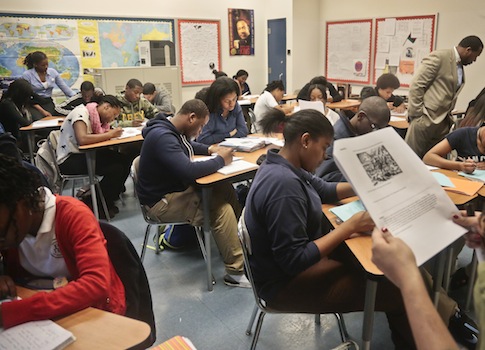American education as we know it may be headed for its last hurrah.
From pre-school to grad school, the system is flailing. Test results have plateaued or fallen. Schools hire more administrators than teachers. College students are shelling out hundreds of thousands of dollars for degrees, and piling up loans, only to end up begging for minimum wage jobs.
In The New School, Glenn Harlan Reynolds provides a concise history of how we got here, and offers a preview of what might be next. In K-12 schooling, Reynolds argues that we’ve stagnated by holding to a nineteenth-century model of education that no longer suits our needs. Meanwhile, higher education has become a bubble about to pop.
Some may be surprised by how new the classroom, with orderly desks and pontificating teachers, really is. Up through the eighteenth-century, most children studied at home. And, as Reynolds observes, this system worked. At the time of the American Revolution, Americans were extremely literate.
Then the industrial revolution hit, the workplace changed, and education standards rose to accommodate it. Society needed a new legion of worker-bees to man the machines. Suddenly scores of people had to be trained to master basic skills like arithmetic and be efficient and obedient.
Horace Mann, a father of modern education, traveled to Prussia and discovered an education system that could do just that. The Prussians’ militaristic education model remains the basis for our schools today. Children stand in lines, learn by rote, and are trained by the bell, just like factory workers.
But, as Reynolds notes, we’re not an industrial society anymore. The needs of the American workplace have once again shifted—but this time, our education system has not shifted with it. Americans want jobs that require them to be creative and forward thinking, but their education is more conducive to fashioning pins in an assembly line.
Then there’s the American university—it, too, is a relatively new institution. College was once only for wealthy elites and pastors-to-be. Today it’s the norm.
New School makes the case that the higher education sector, like the housing sector a few years ago, is a bubble. For years students (and their parents) have spent extravagantly on education, confident that they were making a prudent investment. Government-sponsored loans at artificially low rates encouraged that confidence. Government subsidies and eager buyers allowed colleges to gouge prices.
Reynolds cites a report several years ago by Money Magazine, which claimed, "Adjusting for financial aid, the amount families pay for college has skyrocketed 439% since 1982." But, with scarce jobs and a market rife with unemployed bachelors of the arts, the value of those pricey degrees has not increased with the cost.
Consequently, many students spend four years and thousands of dollars on degrees that have no bearing on the jobs they actually take. Instead of providing useful training, college functions as an outrageously expensive certificate of base-level competence.
Throughout the book, Reynolds repeats a simple mantra: "Something that can’t go on forever, won’t." Something has to give, in both higher and lower education. It’s now merely a question of what exactly will give, and when.
Some small shifts have already begun. Charter schools are gaining popularity, threatening the dominance of traditional public schools. Homeschooling is surging, and shedding its old stigma. Colleges are upping financial aid to retain students.
Reynolds predicts that, as more children leave the public school system, their parents will be reluctant to pay for public schools, and funding will drop. At the same time, jaded, unemployed college grads will discourage others from investing in degrees, and the bubble will burst. Students of all ages will seek alternative forms of education.
Reynolds’ suggestions for the future are heavy on optimism and somewhat light on details. In a chapter he calls "Some Quasi-Predictions," he recounts how he believes his daughter learned money management from playing The Sims. Perhaps, he ventures, one day we will be educated through video games.
Maybe. While video games are entertaining and can convey simple concepts, there’s little reason to think they can foster deep or serious learning. Monopoly might be able to teach basic finance and real estate development. However, subjects like critical thinking and writing are harder to distill into games.
Reynolds also hopes that technology will eventually drive down the cost of education, resulting in a broader distribution of educational opportunities. "When things become cheaper," he asserts, "consumers consume more of them."
That is true—but may not be true when other factors change as well. When technology advances, things rarely remain constant. Technology makes education more available, but it also makes mindless entertainment ubiquitous. The Internet already hosts scores of free literature and online tutorials—but at the end of the day, how many people will watch Miley Cyrus twerking instead of Sal Kahn teaching?
You don’t need to share Reynolds’ optimism to benefit from his excellent introduction to the state of American education. He presents a quick overview of its history, reveals major weaknesses, and prophecies its collapse all in less than 100 pages.
Maybe one day a Sims game could do all of that. For now, you’ll have to stick to the book.
